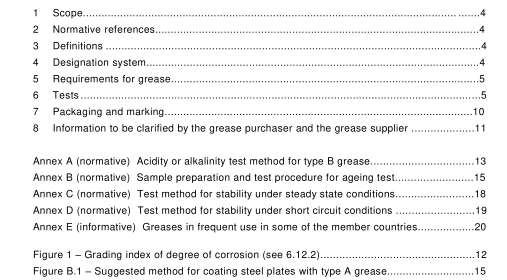BS EN 50326:2002 – Conductors for overhead lines — Characteristics of greases

4.2 The grease supplier shall provide a unique name or code for the grease, and shall retain details of the grease composition for verification purposes. The composition shall include manufacturing tolerances and shall remain unchanged while the grease is marketed under the specific name or code, unless agreement has been reached with the conductor user.
5 Requirements for grease
5.1 The grease shall meet the following requirements.
5.2 The grease shall protect overhead line conductors from atmospheric corrosion in service and in storage. The test requirements in 6.1 2 shall be met.
5.3 The grease shall remain in the conductor for the specified conditions of operation and meet the specified requirements for the service life of the conductor. The requirements of the tests in 6.5, 6.6, 6.7, 6.8, 6.1 0 and 6.1 1 shall be met to demonstrate this, and in addition the tests given in 6.1 3 may be specified by the grease purchaser.
5.4 To demonstrate that the grease may be satisfactorily applied to a conductor with good adhesion, the test requirements in 6.7 and 6.9 shall be met. 6 Tests 6.1 General No test shall be performed at a temperature greater than the maximum safe operating temperature indicated by the grease supplier. All mandatory tests in this standard shall be performed by the grease supplier; grease tests specified in EN 501 82 shall be performed by the conductor manufacturer.
6.2 Classification of tests
6.2.1 Type tests are intended to verify the main characteristics of a grease which depend on its composition. These tests are normally performed only once for a grease supplier’s specific name or code, but shall be repeated if the composition of the grease has changed such that any of the test characteristics given in Table 1 may have changed.
6.2.2 Sample tests are intended to guarantee the quality of the grease and compliance with the requirements of this standard.
6.3 Preconditioning of samples
6.3.1 Type B grease delivered in solid form shall be preconditioned in order to homogenize the grease prior to the tests of 6.5, 6.8, 6.9 and 6.1 0, unless otherwise specified in these subclauses, as follows.
6.3.1 .1 The grease shall be heated to between 1 0 °C and 20 °C above the temperature at which melting occurs, and maintained at this temperature for 0,5 h.
6.3.1 .2 The quantity required for the tests shall be poured, in the liquid state, into the test containers and left to cool for a minimum of 24 h.
6.3.2 Excess oil on the surface of type A grease, as delivered, shall be cause for rejection.
6.4 Temperature accuracy
In all tests referred to in this standard, temperatures shall be measured using equipment with an accuracy of at least 1 LC.
6.5 Drop point test for type B grease
Five determinations of the drop point shall be made using the method given in ISO 21 76.
The minimum value of the five determinations θ m shall be greater than or equal to θ 2
BS EN 50326:2002 – Conductors for overhead lines — Characteristics of greases